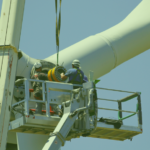Global Wind Workforce Outlook 2023 – 2027 PR
Energy Disrupter

other sectors, including from the conventional sector. This in turn highlights the wind sector’s role in supporting a just and equitable energy transition away from fossil fuels. As a result, the Global Wind Workforce Outlook 2023-2027 highlights an urgent need for faster growth in safety and technical training capacity to meet the anticipated supply chain gaps.
Jakob Lau Holst, CEO of Global Wind Organisation says “Workforce development is top of mind for policymakers, industry associations and employers. The GWO/GWEC Global Wind Workforce Outlook demonstrates not just how many people will be needed for the forecast installation and maintenance of the world’s wind fleet but emphasises how many of these will be new arrivals to the sector. This underlines the need for a renewed focus on entry level skills that match the needs of employers and complements the existing capabilities people bring from other sectors and education systems.”
Ben Backwell, CEO of GWEC adds: “A strong workforce and healthy supply chain will be crucial to the colossal growth of wind capacity in this decade. It is vital that the growing workforce is provided with the tools to train properly, with an approach that puts health and safety at the heart of industry growth. GWEC is delighted to present the Global Wind Workforce Outlook 2023-2027 alongside the Global Wind Organisation. The report sets out how to maintain a safe and healthy work environment and scale up training capacity to meet the demands of a 1.5C-compliant pipeline of wind energy projects around the world. Without a skilled and sustainable workforce for wind and renewable energy, the energy transition will not materialise in time.”
The Outlook highlights onshore and offshore wind growth and workforce needs in 10 countries in particular: Australia, Brazil, China, Colombia, Egypt, India, Japan, Kenya, South Korea and the USA. The high wind power ambitions of these countries must be reinforced by a strong culture of health and safety and a trained workforce. This will be needed to ensure that wind power can continue to support climate and energy targets, and contribute to modern and sustainable economies around the world.
Key insights:
HOW MANY WIND TECHNICIANS WILL REQUIRE STANDARDISED TRAINING FOR THE CONSTRUCTION AND INSTALLATION, AND OPERATION AND MAINTENANCE OF THE GLOBAL WIND FLEET?
By the end of 2027, the worldwide wind fleet will be roughly 1,581GW, more than double the level before the COVID-19 pandemic. Consequently, the number of wind technicians that will require industry training will increase 17% from 489,600 in 2022 to 574,200 in 2027. The number of new wind technicians is expected to increase by 48,800 on average per year from 2023 to 2027.
WHAT IS THE GAP BETWEEN CURRENT LEVELS OF GWO TRAINING AVAILABLE AND THE LEVELS REQUIRED TO TRAIN THE FORECASTED WORKFORCE?
















